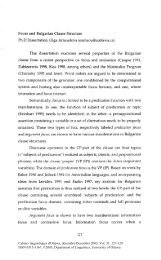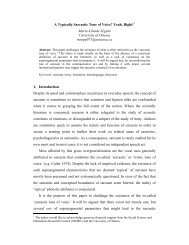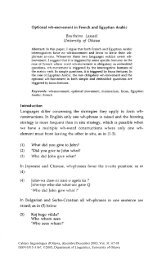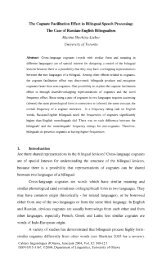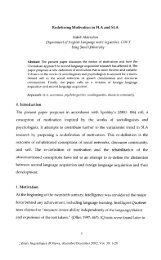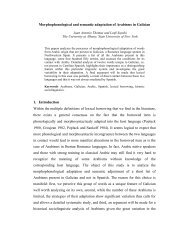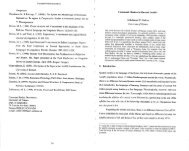Interlingual and Intralingual Interference during Gender Production
Interlingual and Intralingual Interference during Gender Production
Interlingual and Intralingual Interference during Gender Production
Create successful ePaper yourself
Turn your PDF publications into a flip-book with our unique Google optimized e-Paper software.
Denisa Bordag<br />
competition between near-synonyms, because both lemmas turned out to be<br />
phonologically encoded <strong>during</strong> picture naming (with distractors) in a foreign<br />
language (similarly to the way near synonyms are: see Jescheniak & Schriefers<br />
1998, Peterson & Savoy 1998).<br />
The subjective frequencies of foreign language lemmas are, however,<br />
generally low, <strong>and</strong> the links between them weak in comparison with the<br />
frequencies of first language lemmas <strong>and</strong> the strength of connections between<br />
them. It is therefore difficult to overcome their activation <strong>during</strong> second language<br />
production (Hermans et al. 1998). The competition with interfering first language<br />
lemmas then could be one of the reasons why the production of a word in a<br />
foreign language requires considerably more time than in a first language (e.g.<br />
Kroll & Curley 1988, Potter et al.1984) <strong>and</strong> why unintended code switching<br />
occurs, as well as cross-linguistic interference in general.<br />
Theories concerned with how second language speakers (<strong>and</strong> bilinguals)<br />
control their language production (Green 1998, Grosjean 1997, 1998) assume<br />
that language systems can be at different levels of activation <strong>and</strong> that in order to<br />
speak one language rather than another its activation level must exceed that of<br />
the other language (Paradis 1981, Grosjean 1988 <strong>and</strong> later). A further notion is<br />
that regulation is achieved through the modification of levels of activation of<br />
language networks, or items within these networks, rather than via a simple<br />
switch mechanism (De Bot & Schreuder 1993, Grainger & Dijkstra 1992,<br />
Grosjean 1988, Paradis 1981).<br />
Grosjean (1997, 1998) proposes that the activation <strong>and</strong> deactivation of<br />
language systems allows bilinguals to achieve different language modes. In the<br />
monolingual mode, one language is the base language <strong>and</strong> the other is<br />
deactivated at least partially. In contrast, in the bilingual mode (the other extreme<br />
of the bilingual continuum), when individuals are speaking with somebody with<br />
whom they can code-switch or mix languages, both languages are relatively<br />
active, but the activation of the base language is greater. As for the second<br />
language speakers, it is assumed that they cannot prevent their first language<br />
from being at least partly activated <strong>and</strong> thus interfering with the production of<br />
4



